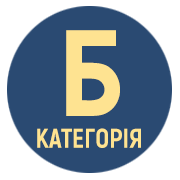Aerobic сapacity of the organism of females of different somatotypes residents in the mountainous regions of Zakarpattia
DOI:
https://doi.org/10.32782/2786-7684/2025-2-21Keywords:
physical performance, energy supply, morphotypeAbstract
Introduction. In the general energy potential of a person, aerobic energy production significantly prevails over anaerobic. Therefore, it is customary to assess physical health by the indicator of maximum oxygen consumption – VO2 max. Individuals of different morphological types differ significantly in terms of the aerobic and anaerobic productivity of the body. At the same time, aerobic productivity in individuals of different somatotypes residing in the mountainous regions of Zakarpattia is currently unstudied. The peculiarities of living in mountainous areas form a certain phenotype in residents according to the indicators of aerobic and anaerobic energy supply systems of muscular activity.Thus, the study of the indicators of aerobic productivity of the body of females of different somatotypes living in the mountainous regions of Zakarpattia will allow us to objectively assess the state of their physical health by taking into account morphological characteristics and the phenotype formed under the influence of the characteristics of the area of r esidence.The purpose to determine the degree of development of aerobic performance indicators of the body of females 16–20 years old of different somatotypes resident’s mountainous areas of Zakarpattia.Methodology and methods of research. The study involved females aged 16-20 years, residents in the mountainous areas of the Zakarpattia (n=102). Aerobic performance of the body was studied using PWC170 indicators, which characterizes physical performance and VO2 max, which characterizes the power of aerobic processes of energy supply of muscular activity. To determine physical performance, the PWC170 bicycle ergometric test was used. The power of aerobic processes of energy supply was calculated based on data on physical performance. The somatotype of the subjects was determined by the Heath-Carter method. The components of the somatotype were determined by anthropometric measurements and mathematical calculations: endomorphy, mesomorphy, and ectomorphy.Results and discussion. Having conducted anthropometric studies to determine the somatotype, we found that among females living in the mountainous regions of Zakarpattia, 5 somatotypes are most common: balanced, mesoectomorphic, ectomorphic, endomorphic and endomesomorphic. According to the absolute PWC170 index, the highest values are demonstrated by representatives of the endomesomorphic somatotype and the lowest by representatives of the ectomorphic and mesoectomorphic somatotypes. According to the relative PWC170 index, the highest values are demonstrated by representatives of the endomesomorphic somatotype and the lowest by representatives of the ectomorphic somatotype.According to the absolute VO2 max index, the highest values a re demonstrated by representatives of the endomesomorphic, balanced and endomorphic somatotypes, and the lowest by representatives of the mesoectomorphic and ectomorphic somatotypes. According to the relative VО2 max indicator, higher values a re demonstrated by representatives of the endomesomorphic somatotype.Summarizing the obtained results, it can be stated that higher values of aerobic productivity indicators of the body are characteristic of girls with a predominance of endomorphy, which indirectly indicates the absence of a negative impact of the fat component on the aerobic productivity of girls living in the mountainous regions of Zakarpattia.Conclusions. Females aged 16-20 of different somatotypes living in the mountainous regions of Zakarpattia significantly differ in the degree of development of aerobic productivity indicators of the body. Higher values are characteristic of representatives of the endomesomorphic and endomorphic somatotypes. Lower values are characteristic of representatives of the mesoectomorphic and ectomorphic somatotypes.The level of aerobic productivity of the body in females living in the mountainous regions of Zakarpattia, regardless of the somatotype, corresponds to "excellent". The average group values of VО2 max rel. representatives of all somatotypes exceed the "critical level of health".
References
Kvashnina LV. Ponyattya adaptatsiyi i adaptovanistʹ yak intehralʹnyy pokaznyk zdorovʺya. Perynatolohiya ta pediatriya, 2000;1:33-36.
Furman YuM. Korekciia aerobnoyi ta anaerobnoyi laktatnoyi produktivnosti organizmu molodi bigovimi navantazhenniami riznogo rezhimu. Dissertation ... doctor of biological sciences: 03.00.13. Kiyiv. 2003;229 p.
Apanasenko GL. Vchennia pro individual'ne zdorov'ia: deiaki pidsumki. L'vivs'kij medichnij chasopis. 2013;(19)1:56-60.
Furman YuM, Miroshnichenko VM, Drachuk SP. Perspektivni modeli fizkul'turno-ozdorovchikh tekhnologij u fizichnomu vikhovanni studentiv vishchikh navchal'nikh zakladiv. Kiyiv: Olimpijs'ka literature. 2013;175 p.
Hargreaves M, Spriet LL. Skeletal muscle energy metabolism during exercise. Nat Metab, Sep, 2020;2(9):817-28. https://doi.org/10.1038/s42255-020-0251-4
Miroshnichenko VM, Furman YM, Bohuslavska VYu, Brezdeniuk OYu, Salnykova SV, Shvets OP, Boiko MO. Functional preparedness of women of the first period of mature age of different somatotypes. Pedagogy of Physical Culture and Sports. 2021;25(5):232-40. https://doi.org/10.15561/26649837.2021.0504
Ryan-Stewart H, Faulkner J, Jobson S. The influence of somatotype on anaerobic performance. Barbosa TM (ed.) PLOS ONE. 2018;13(5): e0197761. https://doi.org/10.1371/journal.pone.0197761
Furman YM, Miroshnichenko VM, Bohuslavska VYu, Gavrylova NV, Brezdeniuk OYu, Salnykova SV, Holovkina VV, Vypasniak IP, Lutskyi VY. Modeling of functional preparedness of women 25-35 years of different somatotypes. Pedagogy of Physical Culture and Sports. 2022;26(2):118-25. https://doi.org/10.15561/26649837.2022.0206
Moore LG, Niermeyer S, Zamudio S. Human adaptation to high altitude: Regional and life-cycle perspectives. Am. J. Phys. Anthropol. 1998;107:25-64. https://doi.org/10.1002/(SICI)1096-8644(1998)107:27+<25::AID-AJPA3>3.0.CO;2-L
Mackenzie B. PWC-170 Cycle Test. [e-article] Brianmac Sports Coache, 2002: Available from: https://www.brianmac. co.uk/pwc170.htm [Accessed 10/5/2021]
Carter J. The Heath-Carter antropometric somatotype. Instruction manual. Department of Exercise and Nutritional Sciences San Diego State University. CA: U.S.A. 2003;26 p.
Kenney LW, Wilmore JH, Costill DL. Physiology of Sport and Exercise. Human Kinetics. 2019;648 р.
Manmohan Sharma, Kamal RB, Kavita Chawla. Correlation of body composition to aerobic capacity; A cross sectional study. International Journal of Applied Research. 2016;2(1):38-42.
Sukanta S. Somatic and Body Composition Factors Underlying Aerobic Capacity. American Journal of Sports Science 2015;3(2):36-40. https://doi.org/10.11648/j.ajss.20150302.12
Miroshnichenko V, Salnykova S, Brezdeniuk O, Nesterova S, Sulyma A, Onyshchuk V, Gavrylova N. The maximum oxygen consumption and body structure component of women at the first period of mature age with a different somatotypes. Pedagogics, Psychology, Medical-Biological Problems of Physical Training and Sports. 2018;22(6):306-12. https://doi.org/10.15561/18189172.2018.0605







